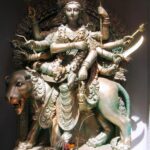
Candraghaṇṭā represents Parvati on her wedding day. Devi Candraghaṇṭā signifies the moon which is connected to the mind. She represents that which charms and captivates the mind.

On the third day of Navratri, Mother Divine manifests as Chandraghanta, also called Chandika, Rannchandi, or Vrikahvahini. Her forehead bears a crescent moon. Chandra means the Moon and Ghaṇṭā refers to a “ bell”.
Chandraghanta embodies beauty itself. True beauty is not merely physical but a manifestation of divine nature. Without this energy, beauty cannot truly exist; this vibrant force that animates life—whether in children, animals, or humans—brings forth genuine charm.
Chandraghanta Devi epitomizes beauty, charm, courage, and grace, embodying all that we find exquisite in life. Her divine energy captivates and attracts us. The third eye, always open, signifies the awakening of consciousness, offering protection from harm to those who seek her blessings. Simultaneously, her formidable form and array of weapons symbolize her readiness to confront and vanquish negative forces. She stands as a symbol of bravery and courage, akin to the lion or tiger she rides, embodying strength against injustice, misery, and suffering. Devi Chandraghanta thus exemplifies both benevolence and fierceness, adapting to the needs of the moment.
After doing years of tapas as Brahmacharini, Shiva accepted her. Her mother was totally against her marrying him but she was persuaded by the rishis to accept him. However, Shiva in his usual quixotic fashion wanted to test her surrender to him and went to Himavan’s palace in his most wretched form with matted locks and three eyes and snake garlands. He was followed by a horrendous riff raff of ghosts and goblins! Shiva’s fearsome appearance terrified Parvati’s family and friends. To protect her loved ones, Parvati transformed into the equally formidable Chandraghanta, persuading Lord Shiva to appear in a more pleasing form. Shiva obliged and manifested as a prince adorned with jewels.
With this reassuring form, Parvati comforted her family and friends, and they celebrated their union with a grand ceremony, commemorated annually as Shivaratri.
She has a golden complexion and is dressed in bright red and adorned with very heavy ornaments. Like her Lord she has three eyes and her crown is decorated by the third-day moon which is shaped like a bell which gave her the name of Chandraghanta. Chandra is moon and ghanta is bell.
Goddess Chandraghanta has ten arms. She carries the trishul (trident), gada (mace), sword and kamandalu in her four left hands and a lotus, arrow, bow and japa mala in her four right hands. The other two hands have the abhaya mudra or the mudra which gives protection and the varada mudra or the mudra for bestowing boons.
She entered the wedding hall in this form, riding on a fierce looking tiger! Her parents had to bow down to her wishes and allow her to marry Shiva.
Chandraghanta portrays a woman who is independent and is prepared to fight for her rights. Her fierce form is capable of destroying obstacles both on the inner path as well as the outside world. Her devotees easily achieve success in life. She bestows divine vision on them. Sometimes they hear divine fragrances and sounds. She is ever ready to destroy the wicked but is a compassionate mother to her devotees. During the battle with the asuras, the deafening sound of her bell is said to have made them drop down senseless.
A symbol of peace, serenity and prosperity. She establishes justice and gives her devotees the courage and strength to fight challenges. Her appearance may be of a source of power which is always busy killing and suppressing the bad and wicked. However, for her devotees, Maa is serene, gentle and peaceful. By worshiping Maa Chrandraghanta, you will open the doors to great respect, fame and glory. Maa also helps you attain spiritual enlightenment. Her idol, which symbolizes both beauty and bravery, gives you the strength to keep the negative energy away and repels all the troubles from your life.
The Moon represents our mind in Vedic astrology, or Jyotish. The Moon is fickle, as is the mind. And the Moon is continually changing its form. The mind is always fluctuating as well; it is not firm. Chandraghanta is ringing a bell and warming the mind to be cautious. She is commanding the mind, “Wake up. Don’t be fickle. Be stable.”She is always warning mind “This is not true path.” Chandraghanta is like a GPS for the mind. Once the mind is stable, God is with you. The mind is a mediator. When the mind is not stable, then God is far away.
Venus or Shukra is her planet. Her favourite colour is red and favourite flower, the lotus. Her abode is in Manipura chakra.
“I bow to that Devi known as Chandraghanta who carries fierce weapons and rides a fierce beast. May she surround me with her grace.”
Oṁ Devī Candraghaṇṭāyai Namaḥ!
ॐ देवी चन्द्रघण्टायै नमः॥